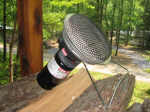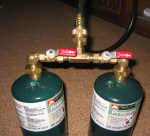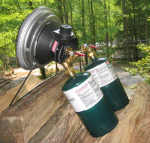| Email John |
| Last update 06/06/2012 |
Two Throwaway Tank Adapter
During my year of over-the-road truck driving I faced a dilemma - how to
stay warm without idling the engine. A big rig diesel engine uses
about a gallon of fuel an hour while idling and that gets expensive, not to
mention noisy.
adapters adapted since 05/22/07

One solution might be to carry a 5 or 20 lb propane tank along. There are several problems with that idea. One, DOT takes a dim view of propane tanks in the cab. Two, size. Three, getting it refilled.
One pound throwaway tanks are much handier. They're easy to store, can be refilled if you don't mind some 'crat getting his panties in a wad and if one runs out he can buy them anywhere. The problem remains, though, that one just isn't enough.
Enter the dual tank adapter.

The male fitting must also be radially oriented properly so that when the heater is tight against it, the legs point down. I achieved this by coating the NPT pipe threads with epoxy, screwing the heater on, tightening the NPT joint until snug and then rotating the heater until the legs pointed down. I allowed the epoxy to cure and everything was locked into place.
A rotary joint is called for here but I didn't have one handy. So far this alignment has worked well.
I used epoxy on all the threads because the whole assembly needs to be rigid.

Use
When I go to bed I start out with one full tank and one from the previous night. The previous night's tank is the combination of the two previous night's tanks combined into one using my Tank Drainer. I connect the two tanks together when I start out and when it's time to sleep, the top tank is drained.
The two tanks tend to equalize levels over the night so in the morning, both are at about the same level.
If I stop during the day for a break, meal or nap, I'll run only one tank (one valve closed). That will more fully drain that tank so it won't take so long for the Tank Drainer to work.
Frost-Up Prevention
This adapter has another use - supplying appliances such as mult-burner cook stoves, radiant heaters and so on that draw propane so rapidly that one tank will frost up. Once frost forms it insulates the tank and the temperature and pressure drop until the appliance may go out. This is particularly troublesome for unattended appliances, as a small amount of propane will still issue forth and will at minimum, stink, and at maximum could cause a fire.
So far I've not run into any appliance designed for throwaway cylinders that uses propane fast enough to frost up two cylinders.